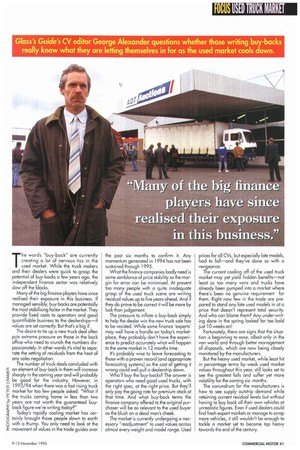Glass's Guide's CV editor George Alexander questions whether those writing
Page 53

If you've noticed an error in this article please click here to report it so we can fix it.
buy-backs really know what they are letting themselves in for as the used market cools down1
The words "buy-back" are currently creating a lot of nervous tics in the used market. While the truck makers and their dealers were quick to grasp the potential of buy-backs a few years ago, the independent finance sector was relatively slow off the blocks.
Many of the big finance players have since realised their exposure in this business. If managed sensibly, buy-backs are potentially the most stabilising factor in the market. They provide fixed costs to operators and good quantifiable business to the dealerships—if values are set correctly. But that's a big if. The desire to tie up a new truck deal often puts extreme pressure on those in the back office who need to crunch the numbers dispassionately. In other words it's vital to separate the setting of residuals from the heat of any sales negotiation.
The number of truck deals concluded with hc, an element of buy-back in them will increase
2 sharply in the coming year and will probably a
i be good for the industry. However, in c.) cc 1993/94 when there was a fast rising truck market far too few people asked: 'What if elthe trucks coming home in less than two >...
-0 years are not worth the guaranteed buy
ack figure we're writing today?"
Today's rapidly cooling market has cer8 tainly brought those people down to earth 5 with a thump. You only need to look at the E movement ot values in the trade guides over
the past six months to confirm it. Any momentum generated in 1994 has not been sustained through 1995.
What the finance companies badly need is some semblance of price stability so the margin for error can be minimised. At present too many people with a quite inadequate grasp of the used truck scene are writing. residual values up to five years ahead. And if they do prove to be correct it will be more by luck than judgement.
The pressure to inflate a buy-back simply to help the dealer win the new truck sale has to be resisted. While some finance 'experts' may well have a handle on today's marketplace, they probably don't have the experience to predict accurately what will happen to the same market in 12 months time.
It's probably wise to leave forecasting to those with a proven record (and appropriate forecasting systems) as the cost of getting it wrong could well pull a dealership down. Who'll buy the buy-backs? The answer is operators who need good used trucks, with the right spec, at the right price. But they'll only pay the going rate for premium stock at that time. And what buy-back terms the finance company offered to the original purchaser will be as relevant to the used buyer as the blush on a dead man's cheek.
The market is currently undergoing a necessary "readjustment" to used values across almost every weight and model range. Used prices for all CVs, but especially late models, had to fall—and they've done so with a vengeance.
The current cooling off of the used truck market may yet yield hidden benefits—not least as too many vans and trucks have already been pumped into a market where there's been no genuine requirement for them. Right now few in the trade are prepared to stand any late used models in at a price that doesn't represent total security. And who can blame them? Any under-writing done in the spring looked far too bold just 10 weeks on!
Fortunately, there are signs that the situation is beginning to ease, albeit only in the van world and through better management of disposals, which are now being closely monitored by the manufacturers. But the heavy used market, while least hit in percentage terms by weak used market values throughout this year, still looks set to see the greatest falls and suffer yet more volatility for the coming six months. The conundrum for the manufacturers is how to see supply outstrip demand while retaining current residual levels but without having to buy back all their own vehicles at unrealistic figures. Even if used dealers could find fresh export markets or manage to scrap more vehicles, it still wouldn't be enough to tackle a market set to become top heavy towards the end of the century.




















































































































